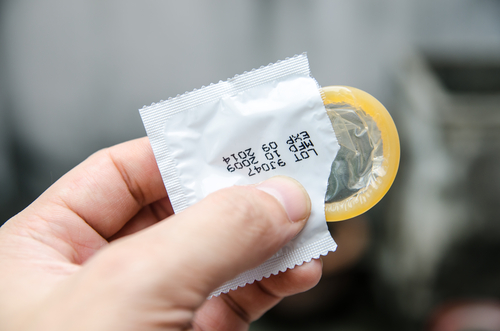HIV-Killing Condoms: The real story from the dendrimer who knows
In 2005, an estimated 4.1 million people worldwide were newly infected with human immunodeficiency virus (HIV) (UNAIDS 2006). – Rupp, Rosenthal and Stanberry, 2007
Who am I?
My name is SPL 7013. I am the active ingredient in those fancy new “HIV-killing condoms” you’ve been hearing about on Facebook and Twitter. The Washington Post claimed I could kill the human immunodeficiency virus (HIV) that causes AIDS. That is not true, for several reasons which I will get into later.
The condoms that use me are produced by Starpharma, a major condom manufacturer in Australia. Starpharma claims that I (or the VivaGel for which I am the active ingredient at 3% weight/weight) have “been shown in laboratory studies to inactivate up to 99.9% of viruses, including HIV, the herpes virus (HSV), and the human papillomavirus (HPV), which are common viruses that cause sexually transmitted infections (STIs).” In the form of VivaGel, I have also been used in clinical trials testing for antiviral effects and treatment of bacterial vaginosis.
I suppose you could call me a bit of a hero of late! But, I’m afraid, I’ve let all this media attention get to my head.
What do I look like?
I am the product of nanotechnology – the science and design of things that are really, really, really small. Like, smaller than your cells small. Like, virus particle small. I am also water soluble (i.e. I like water), which makes me good for drug delivery. There’s a lot of water inside and outside your cells, right?
By the way, I should mention that I am not a living being – I am chemical, a macromolecule. Viruses are also not living creatures, technically. They are rather intricate shells of protein surrounding a core of DNA or RNA. But by copying themselves inside your cells, they “reproduce” in a not-quite-living way. I know, freaky.
I am a branched macromolecule, one of a series of what we in the business call second-generation dendrimers. Think of me as the intricate, 3-dimensional network of the branches of a tree, but at the nanoscale, smaller than many conventional microscopes can see. My branched 3-dimensional structure allows scientists to design me with many different surface features – including the one that allows me to target virus particles such as HIV.
Dendrimers “are a relatively new class of compounds that hold the potential to be safe and effective microbicides.” – Rupp, Rosenthal and Stanberry, 2007
In the case of HIV, I am believed to bind to gp120 proteins on the surface of HIV. Gp120 is essential for virus entry into your (human) cells – it docks to specific receptors, the CD4 receptor, on your cells and acts as a key to the lock of cell entry.
“the United States Food and Drug Administration (FDA) granted VivaGel™ Fast Track status in January 2006 for the prevention of HIV indication (Starpharma 2006a).” – Rupp, Rosenthal and Stanberry, 2007
How do I work?
I am a highly charged – in the electric way – nanoparticle. I belong to a class of compounds known as polyanions – we are highly negatively charged, and thus attracted to positively charged chemicals or receptors (because opposites attract, right?) including positively charged parts of HIV’s Gp120 surface protein. When I bind to or surround HIV’s Gp120 with my negatively charged self, the virus particle has a hard time binding to your (also) negatively charged cells.
My chemistry is a bit more complicated than that, but that’s a simple picture. I prevent virus particles from fusing with your human cells and sending their foreign DNA or RNA where it doesn’t below. I don’t kill HIV, but I’m good at preventing HIV and other viruses from docking into receptors on your cells and making their way inside.
I suppose you could say I blind the HIV particles when I'm around in sufficient numbers? Or I make your cells invisible to the virus?
Can viruses become resistant to me?
I’m not an antibiotic, so I won’t create traditional bacterial resistance to me as some readers have feared in comments online.
In 2005, several researchers showed that I could prevent the herpes simplex virus (HSV) from entering cells, and that I could also prevent the virus from reproducing itself by blocking the formation of new virus DNA. The good news is that over time, I remained just as good at preventing the virus from entering cells prior to infection (African green monkey kidney cells, to be exact). The bad news is that some types of the virus became resistant to my efforts to thwart synthesis of their DNA.
Sneaky viruses - they are always mutating.
Have I been tested in animals or humans?
I have been tested in female pigtailed macaques, an Old World monkey. Administered in a 3% weight/weight solution, I protected 5 out of 6 macaques from infection with SHIV (a non-human primate strain of the virus) compared with the 8 out of 8 macaques who were infected when treated with a placebo vaginal gel (a gel without me in it). Score. But, unfortunately, I can’t claim a 100% effectiveness rating.
In a Phase I clinical trial of 37 health women, I was shown to be safe and well tolerated in healthy, sexually abstinent women, with no evidence of systemic toxicity or absorption, when applied for 7 days in a 3% weight/weight solution. But at 3% and higher concentrations, I can cause irritation. In fact, some researchers have found that I can cause reversible epithelial (tissue) damage with longer term use that could potentially increase your risk of HIV infection. In other words, damaged or broken tissue could increase risk of infection by any HIV virus particles present, so I should be used with caution in gel form.
Another human clinical trial positively showed that “potent antiviral activity was observed against HIV-1 and HSV-2 [herpes simplex virus] immediately following vaginal administration of VivaGel, with activity maintained for at least 3 h[ours] post-dose.”
What about these Condoms?
They are real. However, condoms have never been 100% effective in preventing pregnancy or sexually transmitted diseases, and my condoms aren’t 100% effective (or 99.99% effective) at preventing viral infection.
Yes, approval has been granted for marketing by Okamoto of the VivaGel®-coated condom in Japan – the condom I give antiviral properties to. These condoms will come coated with VivaGel, of which I make up 3% by weight.
Starpharma’s marketing partner Ansell “plans to launch the VivaGel® condom under their brand, LifeStyles Dual Protect™, in the coming months, following listing on the Australian Register of Therapeutic Goods.”
In short, I'm promising but should be used with care.




